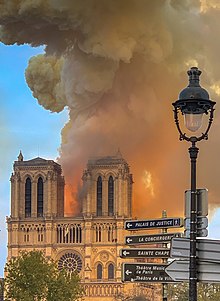Ile de la Cite
The Isle de la Cité (French: Île de la Cité or Isle de la Cité) is located in the middle of the Seine River, in the heart of the city of Paris, France. It is considered as the old center of the city of Paris. It is located in the current districts I and IV. Gui de Bazoches evoked it in 1190 as "the head, heart and marrow of Paris". Its area is approximately 22.5 ha. On January 1, 2007, there were 1,168 inhabitants on the island.
History
It may be the cradle of Paris
For a long time it was thought that a small Gallic tribe called the parisii had lived on the island since 250 BC. The area was rich in fishing and hunting, and access from one side of the Seine to the other was easier thanks to the narrowness of the river. Two wooden footbridges extended the natural north-south path, which descended from the Mount of La Chapelle and went towards the hill of Saint-Genevieve, thus making it possible to avoid the many surrounding marshes. In 52 B.C. C., at the time of the fight between Vercingétorix and Julio César, the parisii actually lived in the surroundings of the island.
But today, historians are more inclined to other hypotheses. Indeed, the parisii could well have settled further away, at the mouth of the Bièvre river (a tributary of the Seine), or on another island that has now disappeared, or even on the peninsula formed by the mouth of the Bièvre, on the left bank of the river (rive gauche).
This entire area of Paris was flooded or swampy, such as the area later called Le Marais ('The Marsh'), and the island itself was completely inundated as late as 1197.
Metamorphosis of the island into an administrative headquarters and a place of tourism
Many projects were drawn up in the mid-XIX century to return to the Ile de la Cité the central role of its origins. A Fourierist who called himself Perreymond, in his Studies on the City of Paris, was one of the first to propose a reconstruction program for the island to make it the religious and cultural center of the capital, thinking of building an opera and a great library. Viollet-le-Duc wanted to build a large episcopal palace close to the cathedral, but he only rebuilt the sacristy of Notre Dame Cathedral.
It was especially the works decided by Baron Haussmann that brought about the greatest changes in the Ile de la Cité since the Middle Ages. The part between the Palace of Justice and the Notre Dame Cathedral was razed, as well as the east of the head. Hundreds of houses and several small churches disappeared. Only two sides of the Place Dauphine and the Notre-Dame cloister escaped demolition. 25,000 people they were expelled. The Cité barracks, which became the Paris Police Prefecture, and the commercial court were built on the place left free. The wide opening of the boulevard of the Palace replaced the winding street of the Barillerie; the rue de la Cité absorbed the old rue du Marché-Palu, de la Juiverie and de la Vieille-Lanterne; Rue de Lutèce replaces Rue de Constantine. The cathedral square was enlarged to cover six times the area it occupied in the Middle Ages, through the demolition of the Hôtel-Dieu hospital, which was rebuilt further north between 1868 and 1875, and through the destruction of the houses of the canons. and of the twenty sanctuaries that surrounded the cathedral according to the medieval tradition. These radical transformations aroused lively protests and are still criticized today for the disappearance of the historic heart of Paris and its millenary history.
Monuments
Three medieval buildings still remain on the Ile de la Cité:
- Notre Dame Cathedral.
- La Sainte Chapelle (1245).
- The Conciergerie.
They are also there:
- The New Bridge, opened in the centuryXVII.
- Paris police prefecture.
- The Paris Palace of Justice.
- Hôtel Dieu, the oldest hospital in the city (not the palace or building that houses it, dating from the years of urban reform of Baron Haussmann).
- The Paris Trade Tribunal
- The Memorial of Deportation Martyrs.
Ile de la Cité has several points of interest: the Vert-Galant (located at the western tip), Jean XXIII (just east of Notre-Dame) and Dauphine (behind the Palace of Justice) squares, and the city's flower market, which is located between the Commercial Court and the Hôtel Dieu.
Contenido relacionado
Hipólito Yrigoyen
Adeje
Geography of Brazil

